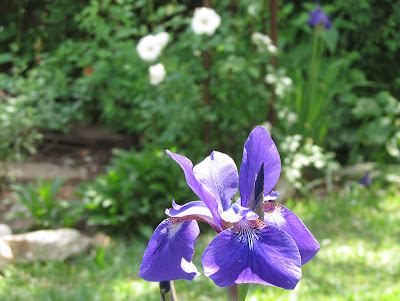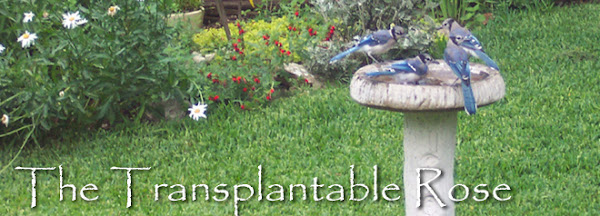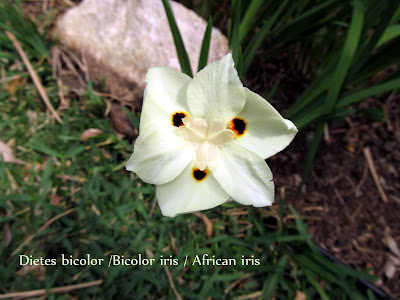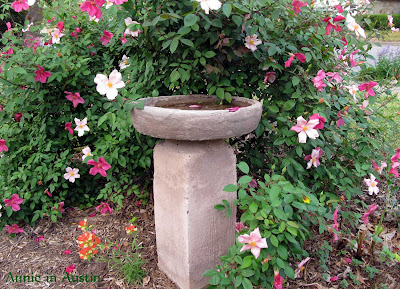When we learned that family members were coming from the North to bask in the sun for a few days, the plan was for the 'Belinda's Dream', 'Mutabilis' and 'Julia Child' roses to be at their most perfect on April 10th, while still looking fabulous for GBBD on the 15th. Well, that was the plan...

'Belinda's Dream' was already an overblown beauty when our son & his dear wife arrived; 'Julia Child' still had buds and the Mutabilis rose was in full glory. But too many days with heat & dry winds made most flowers open too quickly and fall apart even faster.
Today I noticed that 'Julia Child' looks much better when seen from across the garden, veiled by larkspur. Would that work for falling-apart garden bloggers, too?

The timing was absolutely perfect for the Confederate-Star jasmine/
Trachelospermum jasminoides... one plant grows near the steps of the veranda near the drive. Its fragrance is not something you can ignore so luckily our daughter-in-law liked the scent!

The fragrant yellow double Oleander didn't open its first flower until after the guests drove away

The usual show of spring wildflowers along the highways has been muted somewhat by drought. Irrigating all the roadsides in Texas can't be done, but it doesn't take much water to keep a little patch happy in the garden and deadheading extends the season. Here are Blackfoot Daisies, Purple & White Annual Phlox, Texas Paintbrush & Bluebonnets, with the orchid-purple
Salvia greggii in the bottom right corner. Those strappy leaves at lower left belong to the native white rainlilies - they've bloomed on and off all week but not on the 15th!

Here's the view from the other side of the bed - Bluebonnets and Paintbrush with the orchid-purple
Salvia greggii at left. The salvia and rainlilies are perennials. The Bluebonnets are annuals - this time from seed given to me by
MSS of Zanthan Gardens. The Paintbrushes
can be perennial. These have been around a couple of years.

My best guess on the name of the white rainlilies is
Zephyranthes drummondii - or perhaps
Cooperia drummondii or even
Cooperia pedunculata. They grew on the hill behind our first Austin house but to see them bloom, I had to dig up a few bulbs and grow them in deck containers where the deer couldn't get them. I brought them along when we moved here so the white rainlilies now grow in garden beds. This one in the Pink garden was open for GBBD.

Another wildflower was timed perfectly for the visitors: Herbertia, a tiny iris relative that appears in April. Its proper name seems to be
Herbertia lahue. The first plant surprised us when it popped up in the grass in 2005. A few flowers reappear each April but the numbers haven't increased. This is a native Texas plant, but it may have hitched a ride to my yard. Herbertia is reported to grow in large swaths near Houston and I've been told that when our subdivision was built in the 1970's, some of the fill soil came from East Texas. Some wildflower books call it Prairie Nymph - other books say that name belongs to a different flower. Under any name it's worth getting down to ground level for a closer look.

The gauras and salvias in the front beds are budded but not in bloom so let's go around the far side of the house where another Confederate AKA Star Jasmine blooms in the Secret Garden. (The name 'Confederate' is interesting - some references say the plant originated in Asia and the name dates from the 1890's when part of Malasia was the Federated or Confederated Malay States. But with that unsettling hint of Civil War in the name, I sometimes opt for the more neutral 'Star Jasmine'. )

A few feet away, the pomegranate tree has a scattering of flowers and buds. This tree was labeled as variety 'Wonderful' but it's never made a single pomegranate fruit. Look how doubled and ruffled the flower is on my tree:

Last weekend we took our family to Mayfield Park and the pomegranates were in bloom there. I took a photo of the Mayfield variety and noticed that the flowers are simpler and not as congested. This makes me wonder if our pomegranate's blooms are too fluffy for successful pollination.

There's a delicate pink flower not far from the pomegranate in the secret garden - an Indigofera/Pink False Indigo. This plant has a reputation for being a spreader, but in 5 seasons here it's behaved well, tucked in with native ferns and Cast Iron Plant:

Also in the Secret Garden is the Blue Sky vine from
the March GBBD post. The plant was already budded and in bloom when I bought it but now it's down to the last blossom. The vine itself is growing like mad and has reached the top of the arch - maybe there will be more flowers on the new growth?

Through the arch and over to the bed where a bright coral, unlabeled mini-rose planted by some previous owner is in bloom. We've added bulbs like Iphieon/Star Flower, Oxalis and Hippeastrum, the familiar holiday Amaryllis, which can survive outside in Austin.

Also in the bed are other flowers with flowers in the orange/coral range - a few plants of Mountain sage/
Salvia regla that will bloom in fall and this native columbine:

We
made a small bed for a 'Pride of Houston' yaupon under the canopy of the back pecan in 2009. That small bed turned into a new long border in early 2010 and most of the young plants are doing well. Cedar sage/
Salvia roemeriana grows at the high end of the bed near the original yaupon and it looks pretty happy.

Then last week we all went to McKinney Falls state park and for the first time I saw Cedar Sage in its natural environment of hill & rocks in an oak forest. Now my Cedar Sage is demanding a dramatic stone backdrop, too.

The Oakleaf Hydrangea has produced five large flowerheads. Behind the Hydrangea is
Ageratina havanensis, a native fragrant white mist flower, and it's making buds! I'm not sure what's going on -we have two more of these mistflowers in front but they've never bloomed in spring - just in fall.

The front edge of this long bed is in sun - here are Four-nerve daisies, Bluebonnets, Creeping phlox, larkspur, Louisiana iris and Siberian iris

In the background below you can make out a white 'Climbing Iceberg' rose and the original plant of a passalong Siberian iris. A small piece of the iris came from Chicago back in 2005. The small piece took years to become a clump and was finally large enough to divide last year when we made the new bed. Siberian iris sometimes take a while to settle in, so it was a pleasant surprise to get flowers on the new division this spring!

Near the birdbath fountain the 1-year old 'Red Cascade' climbing miniature rose is in bloom, its pure red color looking good against the Lueders stone.

The clematis known as 'Starts-out-ruby-red-then-fades-to-reddish-purple' is in full bloom now - a good surprise. The tangle of vines had become so buggy and moldy that in late winter I cut it down almost to the ground, carefully removing every leaf and washing the trellis. The plant sent out new shoots to cover the trellis by the end of March and the first flower opened the day our family arrived.

Late on Friday afternoon one flower on the 'Little Gem' magnolia swelled to open... but so high up that the zoom couldn't get a good view

And finally, here is my contribution to the Odd Poppy posts from Austin Garden Bloggers (
Robin Getting Grounded,
Rock Rose Jenny,
MSS of Zanthan Gardens) who all experienced unexpected results when they grew Frilly Pink Poppies from seed. Scattering poppy seed hasn't worked for me, so I bought a few started plants from the Natural Gardener on March 6th. The only color I could find was labeled 'Maroon'. A few days ago they looked like this:

But soon after the other bloggers mentioned frilly pink poppies one appeared in my garden... maybe a stray seed in with the maroon plant?

This one's a bit salmon-pink but it should be good enough to get me in the Frilly Pink Poppy club!

As you can see we're long past tulip & daffodil season here in Texas - to see those traditional spring favorites and to check out what's blooming all over the world go to Carol's round up over at
May Dreams Gardens. , the Garden Blogger Bloom Day headquarters.
For more about Mayfield Park, see
Carolyn's Caroline's delightful
tour of Mayfield Park on her blog, The Shovel Ready Garden. We fell in love with this garden museum more than a decade ago - maybe you will, too.
For the complete April list of blooms with my best guess at botanical names, please go to
Annie's Addendum.





 Here's the back of this bird
Here's the back of this bird  A similar bird was around in January, so maybe they're not just passing through.
A similar bird was around in January, so maybe they're not just passing through.





 Thanks for any input ... there is some video footage of the little birds hopping around on the fountain - it can go up on YouTube once they have names.
Thanks for any input ... there is some video footage of the little birds hopping around on the fountain - it can go up on YouTube once they have names.














































